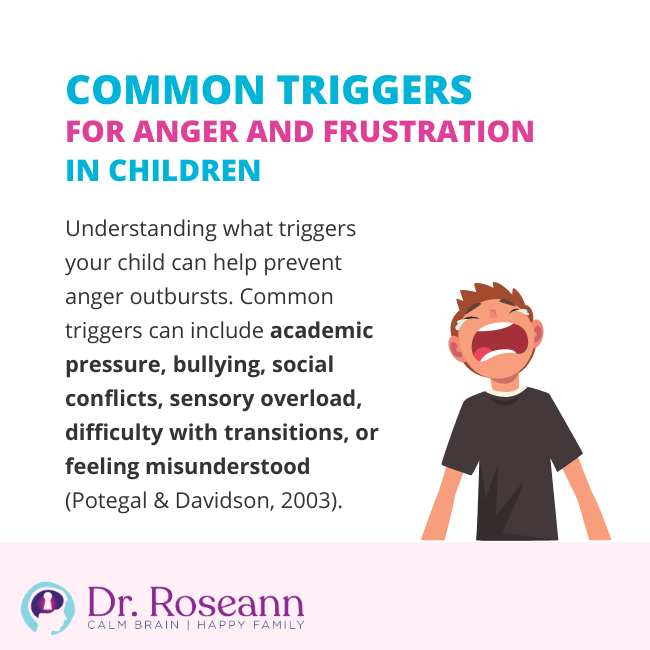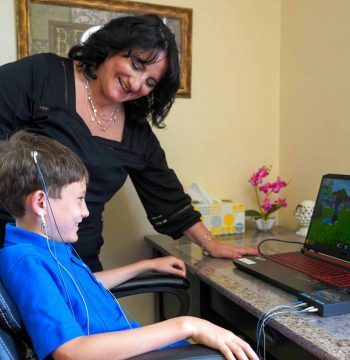Children experience a gamut of emotions, just like adults. Anger and frustration are normal feelings that every child will experience. However, children may not yet have the emotional vocabulary or coping mechanisms to manage these intense emotions effectively (Denham, 2006).
These feelings can become even more pronounced and difficult to manage in children diagnosed with behavioral and mental health issues such as ADHD, RSD, autism, OCD, anxiety, mood disorders, PANS/PANDAS.
The Importance of Anger Management for Children
Anger and frustration management is not just about preventing outbursts—it can also significantly contribute to children's mental and emotional health, academic success, social relationships, and overall life satisfaction (Kassinove & Sukhodolsky, 1995). Moreover, equipping them with effective anger management strategies can help them become resilient adults who can navigate life's challenges successfully.
Signs of Anger Management Issues in Children
Recognizing the signs of anger management issues in children early on is crucial for implementing timely and effective intervention strategies. The symptoms of anger management issues can vary widely from one child to another, often depending on their age, developmental stage, and personal circumstances. However, there are some common signs that parents and caregivers can look out for:
- Frequent Temper Tantrums: While temper tantrums can be a normal part of childhood development, frequent, intense, or prolonged tantrums can be a sign of underlying anger management issues. These tantrums can often seem out of proportion to the situation or trigger (Potegal & Davidson, 2003).
- Aggressive Behavior Towards Others: This can include physical aggression like hitting or biting, or verbal aggression such as yelling, threatening, or using hurtful words. It's important to note that aggressive behavior is not always a sign of anger management issues, but when it becomes frequent or severe, it can indicate a problem (Patterson, DeBaryshe, & Ramsey, 1990).
- Destructiveness: Children with anger management issues may often break or damage things in their environment, either intentionally or as a result of uncontrolled outbursts (Greene, 2010).
- Regular Defiance: Persistent defiance, oppositional behavior, or refusal to comply with rules or instructions can also be a sign of anger management issues. This can manifest as a constant power struggle between the child and their caregivers or teachers (Greene, 2010).
- Academic or Social Difficulties: Children struggling with anger management may often have trouble at school or in social situations. They may have difficulty focusing on tasks, following instructions, or getting along with peers. These difficulties can often result in poor academic performance or social isolation (Greene, 2010).
If these behaviors persist, intensify, or interfere with the child's daily activities, it may indicate a need for additional support, such as professional intervention. It's important to remember that every child is different, and what might be a sign of anger management issues in one child may not be in another. It's always best to consult with a healthcare provider or a mental health professional if you have concerns about your child's behavior.
Common Triggers for Anger and Frustration in Children

Understanding what triggers your child can help prevent anger outbursts. Common triggers can include academic pressure, bullying, social conflicts, sensory overload, difficulty with transitions, or feeling misunderstood (Potegal & Davidson, 2003). For children with mental health conditions, these triggers can cause a more intense reaction.
The Consequences of Uncontrolled Anger and Frustration
If left unchecked, anger and frustration can lead to serious repercussions, including damaged relationships, academic underachievement, and even mental health challenges, such as anxiety and depression (Deffenbacher, 2011). Moreover, it can also impact a child's self-esteem and overall quality of life.
The Role of Communication in Anger and Frustration Management
Open and empathetic communication can be a powerful tool in managing anger and frustration. It can help children understand their emotions, feel validated, and learn effective ways to express their feelings (Patterson, DeBaryshe, & Ramsey, 1990).
However, it's important to acknowledge that communication with children, especially those dealing with behavioral or mental health issues, can sometimes become a source of frustration itself. There may be moments when it feels as if you and your child are speaking different languages, leading to misunderstandings, escalated emotions, and conflict (Gottman, 1997).
Broken communication happens when children are unable to express their emotions accurately, or when parents, despite their best intentions, may miss or misinterpret the emotional cues from their child. It's essential, in these instances, to approach such communication breakdowns with patience and empathy.
Understand that your child is not intentionally trying to be difficult, but may be struggling to articulate their feelings. Similarly, as a parent, it's okay to admit when you're having difficulty understanding and ask for clarification.
Remember, effective communication is a two-way process. It's about listening and understanding as much as it is about expressing. There are communication strategies that can help but, taking the time to truly understand your child's perspective can make a significant difference in their ability to manage anger and frustration.
Creating a Calm Environment at Home

Creating a peaceful home environment is a crucial aspect of managing anger and frustration in children. A calm, organized, and predictable environment can alleviate potential stressors that might trigger emotional outbursts, providing a stable foundation for children to explore, grow, and express themselves.
Establishing Routines
Predictable routines can provide a sense of security for children, particularly those with behavioral or mental health conditions (Forehand & McMahon, 1981). This could include consistent meal times, bedtime routines, and a regular schedule for chores or homework. A stable routine can provide clear expectations, reducing uncertainty and potential conflict.
Minimizing Clutter
A cluttered environment can lead to sensory overload and increase stress levels in children (Saxberg, 2017). It's beneficial to maintain an organized space with designated areas for play, study, and rest. This not only makes the environment more pleasant but also helps children understand where things belong and encourages responsibility.
Creating a Safe Space
It's essential for children to feel that their home is a safe space where they are heard and understood. This involves active listening, showing empathy, and validating their feelings. Regular family time, where everyone can share their experiences and feelings, can foster a strong sense of belonging and understanding (Siegel & Bryson, 2012).
Incorporating Sensory Items
Sensory items can also be a valuable addition to a calming home environment. These might include soft blankets or pillows, weighted lap pads, or fidget toys, which can provide comforting tactile input (Champagne, 2008).
For auditory calming, consider soothing music or nature sounds. Visual calm can be promoted through items like lava lamps, fish tanks, or slow-moving mobiles. These sensory items can help to ground children, particularly during times of high stress or anxiety, and can be a powerful tool in their self-regulation toolkit.
By considering these elements, we can create a home environment that not only reduces potential triggers of anger and frustration but also supports children in managing these feelings when they do arise.
Effective Strategies for Managing Anger and Frustration in Children

Emotions, particularly strong ones like anger and frustration, can sometimes overwhelm children, leading to outbursts and challenging behavior. It is essential, therefore, to equip them with effective strategies to handle these emotions, transforming them from potential triggers of disruption into opportunities for learning and growth.
The good news is that there are research-backed strategies that can help children manage their anger and frustration. From calming the brain to reinforcing desired behaviors, and ensuring consistency, these methods aim to empower children with the tools they need to navigate their emotions effectively.
With practice and patience, these strategies can help your child gain control over their anger and frustration, leading to a more peaceful and productive environment at home and in school.
Calm the Brain
Techniques like deep breathing, progressive muscle relaxation, visualization, and mindfulness can help children calm their overactive brains and manage their emotional responses effectively (Siegel & Bryson, 2012).
Reinforce Desired Behaviors
Positive reinforcement can motivate children to control their anger and frustration. This could be in the form of praise, rewards, or privileges for displaying appropriate behavior (Fabiano et al., 2009).
Be Consistent
No one wants to hear this but consistency in rules, expectations, and consequences helps children learn and practice anger management skills. It provides a sense of stability and predictability, which can be reassuring for children, particularly those with behavioral or mental health conditions (Forehand & McMahon, 1981). Instead of feeling overwhelmed by the needs for consistent reinforcement, be empowered that your actions make a difference. It certainly did for Charles.
Techniques for Teaching Children How to Control Their Anger and Frustration
There are several techniques to teach children to control their anger and frustration. These include teaching them problem-solving skills to help them navigate challenging situations, distraction techniques to divert their attention from triggers, cognitive restructuring to change negative thought patterns, and relaxation techniques to calm their mind and body (Sukhodolsky et al., 2016).
Role-Playing Exercises for Anger Management
Role-playing can be a powerful tool in teaching children how to manage their anger. By acting out different scenarios, children can practice expressing their feelings appropriately, understand others' perspectives, and learn effective problem-solving strategies (Lipton & Nowicki, 2009).
Professional Resources for Anger Management
If your child continues to struggle with anger and frustration, seeking professional help can be beneficial. Cognitive Behavioral Therapy (CBT), Neurofeedback, and specialized programs like the BrainBehaviorReset™ Program have proven effective in managing these emotions in children (Moriyama et al., 2013).
Consider Charles, a child who struggled with persistent anger to the point that his school had to involve the police due to his aggressive behavior. After utilizing the BrainBehaviorReset™ Program, which combines neurofeedback, CALM PEMF™, supplements, and counseling, Charles was able to substantially improve his behavior. From being a disruptive elementary school student, he transformed into a happy, well-liked high schooler, demonstrating the power of professional resources in anger management.
Common Mistakes to Avoid When Dealing with Anger and Frustration in Children
It's important to avoid certain common mistakes when dealing with your child's anger and frustration. These include ignoring or invalidating the child's feelings, punishing them for expressing anger, or being inconsistent in your responses (Siegel & Bryson, 2012). Remember, your child needs your understanding and support to manage these strong emotions effectively.
Helping Your Child Master Their Emotions for a Happier and Healthier Life
Teaching children to manage their anger and frustration is not a quick or easy process. It requires patience, understanding, and consistency. But with the right strategies and support, you can help your child navigate their emotions effectively, leading to a happier, healthier, and more fulfilling life.
Citations:
Boyce, W. T. (2010). Home environments and children's health. Environmental Health Perspectives, 118(10), A426.
Champagne, T. (2008). Sensory modulation & environment: Essential elements of occupation. Sidney, NY: Champagne Conferences & Consultation.
Deffenbacher, J. L. (2011). Cognitive-behavioral conceptualization and treatment of anger. Cognitive and Behavioral Practice, 18(2), 212-221.
Denham, S. A. (2006). Social-emotional competence as support for school readiness: What is it and how do we assess it? Early Education and Development, 17(1), 57-89.
Fabiano, G. A., Pelham, W. E., Coles, E. K., Gnagy, E. M., Chronis-Tuscano, A., & O'Connor, B. C. (2009). A meta-analysis of behavioral treatments for attention-deficit/hyperactivity disorder. Clinical Psychology Review, 29(2), 129-140.
Forehand, R., & McMahon, R. J. (1981). Helping the noncompliant child: a clinician's guide to effective parent training. New York: Guilford Press.
Greene, R. W. (2010). The explosive child: A new approach for understanding and parenting easily frustrated, chronically inflexible children. New York, NY: HarperCollins.
Gottman, J. M. (1997). Raising an emotionally intelligent child. New York, NY: Simon & Schuster.
Kassinove, H.,& Sukhodolsky, D. G. (1995). Anger disorders: Basic science and practice issues. Issues in Comprehensive Pediatric Nursing, 18(3), 173-205.
Lipton, M. L., & Nowicki, S. (2009). The social-emotional learning framework (SELF): A guide for understanding brain-based social-emotional learning impairments. Journal of Developmental and Physical Disabilities, 21(1), 69-88.
Moriyama, T. S., Polanczyk, G., Caye, A., Banaschewski, T., Brandeis, D., & Rohde, L. A. (2013). Evidence-based information on the clinical use of neurofeedback for ADHD. Neurotherapeutics, 10(3), 588-598.
Patterson, G. R., DeBaryshe, B. D., & Ramsey, E. (1990). A developmental perspective on antisocial behavior. American Psychologist, 44(2), 329.
Potegal, M., & Davidson, R. J. (2003). Temper tantrums in young children: 1. Behavioral composition. Journal of Developmental and Behavioral Pediatrics, 24(3), 140-147.
Sukhodolsky, D. G., Smith, S. D., McCauley, S. A., Ibrahim, K., & Piasecka, J. B. (2016). Behavioral interventions for anger, irritability, and aggression in children and adolescents. Journal of Child and Adolescent Psychopharmacology, 26(1), 58-64.
Always remember… “Calm Brain, Happy Family™”
Are you looking for SOLUTIONS for your struggling child or teen?
Dr. Roseann and her team are all about solutions, so you are in the right place!
There are 3 ways to work with Dr. Roseann:
You can get her books for parents and professionals, including: It’s Gonna Be OK™: Proven Ways to Improve Your Child’s Mental Health, Teletherapy Toolkit™ and Brain Under Attack: A Resource For Parents and Caregivers of Children With PANS, PANDAS, and Autoimmune Encephalopathy.
If you are a business or organization that needs proactive guidance to support employee mental health or an organization looking for a brand representative, check out Dr. Roseann’s media page and professional speaking page to see how we can work together.
Dr. Roseann is a Children’s Mental Health Expert and Therapist who has been featured in/on hundreds of media outlets including, CBS, NBC, FOX News, PIX11 NYC, The New York Times, The Washington Post,, Business Insider, USA Today, CNET, Marth Stewart, and PARENTS. FORBES called her, “A thought leader in children’s mental health.”

She is the founder and director of The Global Institute of Children’s Mental Health and Dr. Roseann Capanna-Hodge. Dr. Roseann is a Board Certified Neurofeedback (BCN) Practitioner, a Board Member of the Northeast Region Biofeedback Society (NRBS), Certified Integrative Medicine Mental Health Provider (CMHIMP) and an Amen Clinic Certified Brain Health Coach. She is also a member of The International Lyme Disease and Associated Disease Society (ILADS), The American Psychological Association (APA), Anxiety and Depression Association of America (ADAA) National Association of School Psychologists (NASP), International OCD Foundation (IOCDF) International Society for Neurofeedback and Research (ISNR) and The Association of Applied Psychophysiology and Biofeedback (AAPB).
© Roseann-Capanna-Hodge, LLC 2023
Disclaimer: This article is not intended to give health advice and it is recommended to consult with a physician before beginning any new wellness regime. *The effectiveness of diagnosis and treatment vary by patient and condition. Dr. Roseann Capanna-Hodge, LLC does not guarantee certain results.













